
Welcome to special coverage of the Cellular Telecommunications Industry Association Conference (CTIA) and the Microsoft Mobility Developers Conference, held this past week in New Orleans.Editor and General Manager, Joe Francica covered the news from the show, the keynote messages, as well as insights into the development of the location-based services market.
Executive Summary - CTIA
Wireless communication and the deployment of location-based services with mobile devices can best be described as a "maturing early adopter" market.The applications are further down the path of development than they were last year and "marketable" services are now in use.The mobile devices are more capable of displaying location information, whether rendered as maps or as plain text due to improvements in and availability of content as well as screen resolution that accompany various form factors, such as PDA's, cell phones, or wrist watches.The wireless carriers, though not out of the woods financially, have pushed cautiously into installing position determination equipment at cell tower locations or applying assisted GPS technology.Equally cautious is the delivery of "location aware" handsets by cell phone manufacturers by installing GPS chipsets in some of the newer handsets.The middleware solution companies, those that provide suites of applications such as geocoding, routing, spatial context (point in polygon, MBR, etc.) or the integration of real-time, dynamic information, have gone through a period of market adjustment and have emerged with significant visibility among carriers.And although the demonstrations of consumer applications ("Friend Finder", "Meet me for Coffee") are most intriguing, enterprise applications in fleet management, asset tracking, and sales team mobility are the most viable as productivity tools to assist the mobile workforce.
"You can not think of mobility without thinking of location," said Steve Lombardi, Microsoft MapPoint Product Evangelist and contributing columnist to Directions Magazine on LBS.Directions has reported before on the "mood swings" of LBS before and at CTIA there was certainly some optimism that the next 12 to 24 months would push the market beyond the "chasm" with products and services that would be both adopted in the enterprise and consumer market.Jim Vandermeer of Airbiquity, another one of our contributing columnist on LBS, has eloquently described some of the same fundamental market shifts that he has seen in a recent article (see "LBS: Turning Corners in 2003").
Executive Summary - Microsoft Mobility Developers Conference
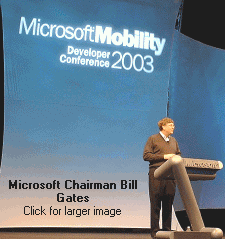
The Microsoft Mobility Developers Conference was the first such conference
to be held and featured Bill Gates, chairman and chief software architect,
as the keynoter.For location services, there were a few key announcements.
First, there was a name change for the location technology platform from
MapPoint.NET to MapPoint Web Services.The change reflects how Microsoft
wants to position of the all location solutions or products you can expect
to see delivered from the MapPoint Group."For us, we use the term .NET
to describe all the work we're doing to enable Web services, so that version
of Visual Studio, the version of our server products are branded .NET,
the run time capability we have .NET Framework, and the small byte code
environment for mobile devices is the .NET Compact Framework.So it's about
connecting all the devices, information and people together easily, said
Gates.
The MapPoint Group was recently transferred to Microsoft's Mobile Devices Division but will still be managed by Michael Graff.Web Services, as Microsoft sees it with respect to location technology, is a delivery system for applications and data.The important distinction is that many in the GIS industry have described Web Services in the context of supplying data only.In such instances, the application was assumed to have been already built.In terms of MapPoint Web Services, whether it is a geocoding app that gets embedded into an asset tracking system, or a slice of demographic data that is delivered from a server to a spatial analysis solution, either is a "service" that can be creatively constructed for web deployment.MapPoint Web Service provides street-level coverage in 17 countries and obviously includes an international geocoder. For more information, go to the MapPoint® Web Service Fact Sheet.
Microsoft sees XML Web Services invading many mobile platforms."This
is essentially the infrastructure that's necessary to fulfill the promises
of the late '90s, and early in this decade about what the Internet would
do.It goes beyond browsing, to say that software running on any computer
can discover software on another computer and agree on a protocol to exchange
very rich information.That's a platform advance that's very necessary
for e-commerce," said Gates."XML Web services are a perfect fit for mobile
devices, because they allow the code on the device to go and get services
remotely."
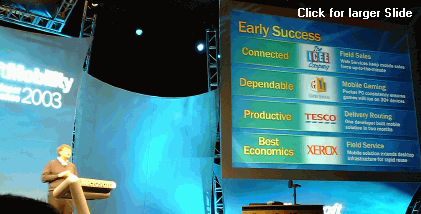
Another feature of the conference was the launch of Microsoft Compact
Framework for the development of applications on mobile devices, in particular
"SmartPhones." Microsoft is investing heavily in Smartphones."Microsoft
is just at the beginning of what it's doing in this business.We've said
that about many businesses before, and I think we have a very strong track
record of credibility when we say we're going to invest that we do that,
and follow-through, literally, for decades in evolving the platform in
a very compatible way, making it work with all the different things that
it needs to work with," commented Gates.The .NET Compact Framework will
be delivered as part of Visual Studio 2003.
One of the demonstrations shown during the keynote was called "Meet
Me for Coffee." The 'smart' devices in this case were a PDA, a phone and
wristwatch, all of which were location aware.This went beyond the simple
"Friend Finder" services now available with the AT&T Wireless network
which allows you to locate a friend in proximity to yourself.The "Meet
Me for Coffee" application provides a location for all of the people whom
you "invite" to meet at a certain destination.As a location-aware device,
the web service allows the 'invitor' to identify a nearby coffee shop in
closest proximity to all attendees; shows the distance to each invitee;
and sends the invitation along with the address.
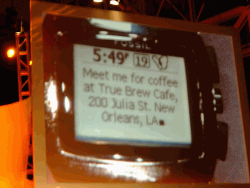
However, most interesting part of Gate's entire presentation that had
direct bearing on the location services sector was his vision of where
he thought mobile solutions will continue to develop upon the early successes
in the delivery of Web Services.In the above image, Gates showed a
slide of four areas where these successes have been demonstrated already
and three of them had a location component: Field Sales, Delivery Routing,
and Field Service.In fact, as we at Directions have pointed out several
times, Field Service and Delivery Routing are areas where some of the best
returns on investment can be demonstrated.[Click the following link for
a transcript
of Bill Gates' Keynote.]
CTIA Keynote: A Conversation with Ted Turner
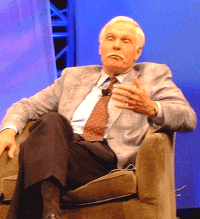
Ted Turner's accomplishments span beyond the world of media.The man
has literally changed the way we comprehend and interpret world events.
More than likely, you have at some time today turned your television to
CNN to determine the latest on the Iraq war.Mr.Turner's vision of a 24-hour,
all news network was both risky and visionary, and when it launched in
1980, it had its share of critics.Mr.Turner was also the founder of the
"Goodwill Games" and his name appears on other cable ventures such as Turner
Broadcasting (TBS), Turner Network Television (TNT), and Turner Classic
Movies (TCM).He also founded The Cartoon Network and SportsSouth
and was the owner of the Atlanta Braves professional baseball team before
all of his ventures were merged into AOL Time Warner, a business decision
he now calls a "debacle."
"I had the idea for CNN for many, many years.I think we went on the
first satellite with TBS back in '76...and even before that, Home Box Office
(HBO) went off about a year earlier...It was not my idea to use the satellite
to interpret the programming ...HBO had already come up with the idea.
You got HBO already up there; you got the networks all over the country;
and you got the SuperStation (TBS) with all of the movies and sporting
events, what would be the next service that people would like to have...And
I had been in the radio business, and I knew that there was all news radio,
and it was in the major markets.If an all news radio station could make
it, an all news television station would be very convenient because you
could turn the news on whenever you need it," said Turner.
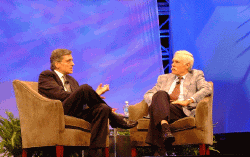
But perhaps most impressive about Turner, whose fortunes have risen
and fallen over the years, is his philanthropy.Turner pledged $1 Billion
to the United Nations over 5 years and his speaking fee of $50,000 for
his appearance at CTIA was donated to one of his charities.